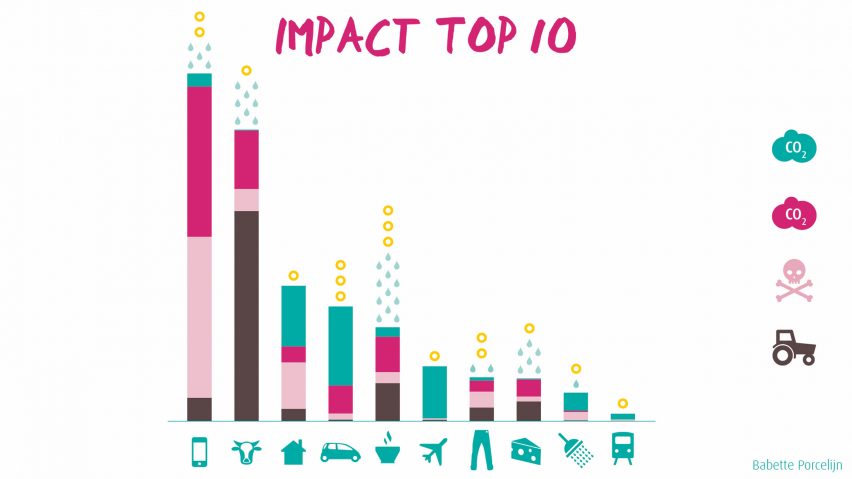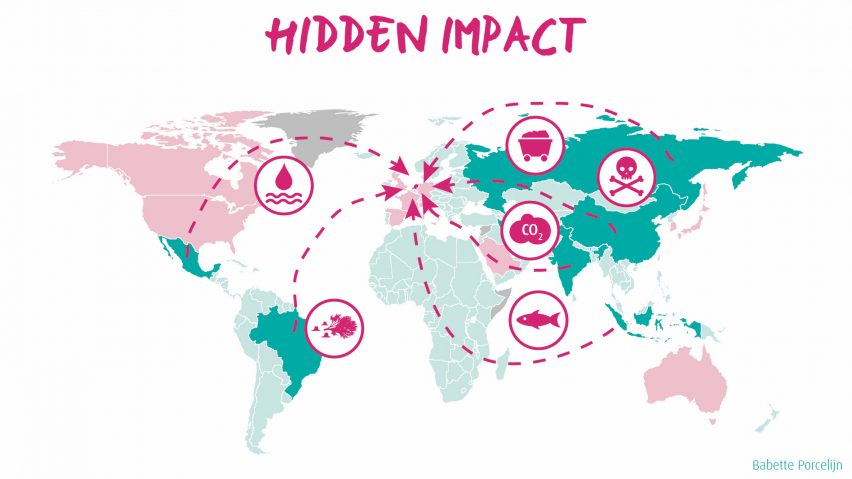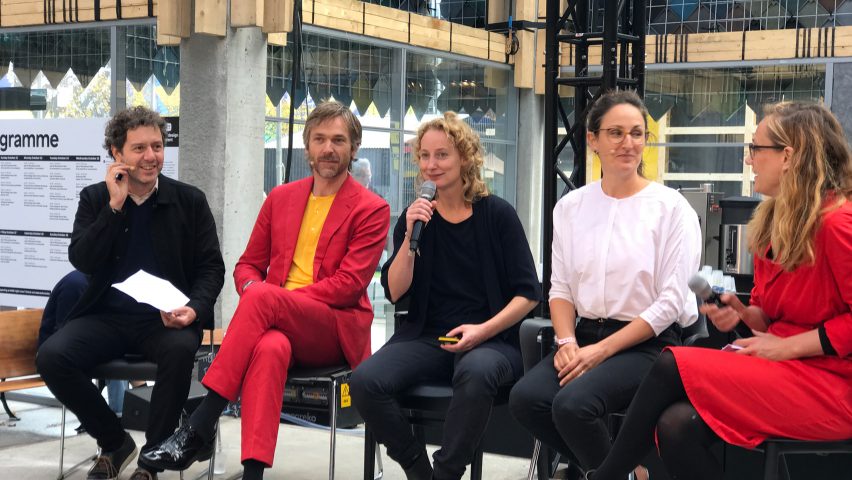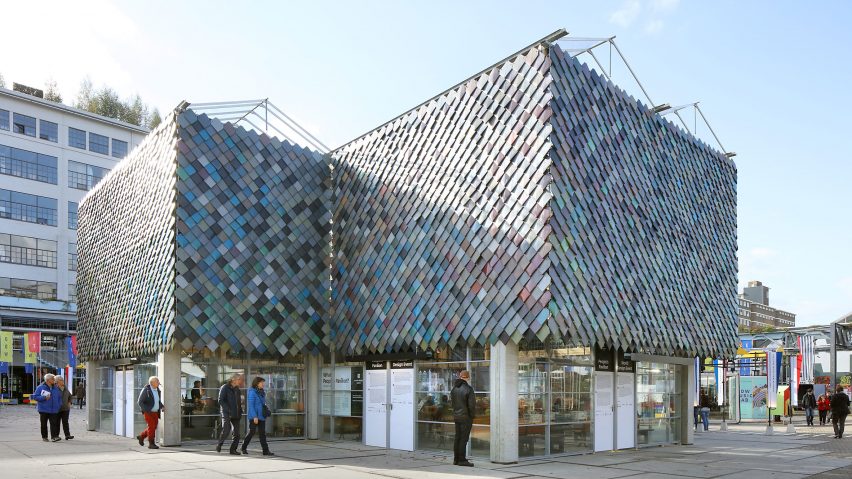Mobile phones and other industrial products have "the number one impact" on climate change
The products that designers help create are the biggest contributors to climate change, according to research presented at our Good Design for a Bad World talks at Dutch Design Week last month.
The claim came from designer Babette Porcelijn, who has published a book that explores the factors driving climate change and other environmental issues, and offers potential solutions.
"I made an impact top 10," said Porcelijn, presenting a graph of the 10 biggest causes of environmental impact. "Number one is products. It's stuff. I'm an industrial designer so I was really educated to make these things. But it has the number one impact."
Electronic products such as mobile phones and computers are among the biggest contributors, she said, adding that her list contains more surprises, with animal farming coming second.
"Number two is meat," she said. "Then comes houses, then comes the car."

The findings are contained in her book, De Verborgen Impact (Hidden Impact), which explores the hidden impact of human activities on earth's climate, which most people are unaware of.
"We moved a lot of our industry and agriculture to low wage countries," she explained. "There they make a lot of our stuff, which we import and buy."
"But this production has lots of impact on the environment and is not just climate impact, it's also impacting nature and the environment. It's polluting. It's causing deforestation and putting fresh water under pressure, to just name a few things.
"And since we buy all this stuff, these products and food, it makes us at least partly responsible," she said. "But we have no idea because we usually leave out all that impact and thus we kind of like create a blind spot in our assessment of environmental impact."
She also claims that the manufacturing and use of plastic is not a big contributor to greenhouse gases. However the environmental problems caused by plastics being thrown away is a huge problem, she said.
"Using plastic and producing plastic is not the problem. But throwing it in nature, that's the problem we should solve," she stated. "I researched plastic pollution for the latest edition of my book and one of the findings is that producing plastic doesn't have a lot of impact."
"The point is when you throw it on the street and it comes into the environment, into nature, that's where it hurts."

Plastic microbeads – particles less than a millimetre in diameter – have been identified as a major environmental problem, with tiny plastic particles polluting the oceans and making their way into the food chain. The UK and several US states have moved to ban them from cosmetic and cleaning products, where they are used for their abrasive properties.
However Porcelijn said their impact on the environment was dwarfed by fragments of synthetic rubber produced by cars as their tyres wear down.
"One of the biggest causes of microplastics is not in the bathroom at all," she said. "It's from tyre wear. It's from your car, driving your car. If you drive for one kilometre, you have released more microbeads into nature than you do in one year in the bathroom."
Porcelijn also claimed that if every person in the world consumed resources at the same rate as people in the west, we would need almost four planet earths to provide for them all.
"If everyone in the world would live like we do here today in Holland, we would need three point six planets to support us, she said.

The talk, held in the temporary People's Pavilion in Eindhoven, was the first in a series of five Good Design for a Bad World talks that Dezeen hosted during Dutch Design Week.
Each talk explored how designers are addressing a different problem and asked whether the ideas they are coming up with can scale up to offer viable solutions.
Porcelijn was joined on the climate-change panel by Annemartine van Kesteren, who is a curator at Museum Boijmans Van Beuningen in Rotterdam.
Most recently Van Kesteren curated Change the System, an exhibition that showcases ways that designers are responding to the world's problems.
As an example, she spoke about an installation in the exhibition created by product designer Eric Klarenbeek, together with Arles-based design studio Atelier Luma, which explores using algae as an alternative raw material for plastic.
"He's basically saying we should stop completely with plastics and oil production and [instead use] algae and different biopolymers," she said.
When asked whether ideas like this could be adopted by governments and industry, Van Kesteren said that existing systems were resistant to change and designers should instead strive independently to create new systems from the ground up.
"There's nothing, nothing so rigid as a system," she said. "And there's no system that wants to change. It's very important that designers remain autonomous."
Lonny van Ryswyck of Atelier NL agreed, saying designers needed to "start really small" to address issues such as climate change, since industry wants to retain the status quo.
"Systems are very rigid," she said, explaining how the global glass industry uses just one type of sand, which is running out and which is being illegally mined from riverbeds and beaches around the world, causing environmental damage.
"That's what we are facing in our project making from local sand glass. The industry doesn't want to go upward with us because they have a certain way of producing and that's all about efficiency and all about mass production."

Richard van der Laken, co-founder of the What Design Can Do conference and initiator of this year's Climate Action Challenge initiative, said that the question of whether even the most well-meaning corporations were willing and able to change their ways to reduce their own emissions was "a difficult question to answer."
Designers should therefore focus on using their skills to communicate environmental messages to the public, rather than striving to change their clients from within.
"I think it's really important that we as designers are all aware of the fact that we can make things tangible, that we can make things visual, that we can bring feeling and passion into it and I think that's the real power that design can bring," he said.
"There's a lot of innovation and a lot of technology and I think that designers are able to translate that into stuff and services that people can understand."
However Porcelijn disagreed that designers should be satisfied with merely being communicators and messengers. "The fact that we as designers can create awareness is enough," she said. "What we have to do, what we can do, what we have the power to do, is to think of new ways to solve problems. That's what we do as designers."
"My slogan is think big, act now," she said. "Look at how you can save the world but make it actionable in a small project that you can do and that you love to do."

Van Ryswyck said that many young designers she meets are desperate to help solve big problems like climate change but "get lost" in the immensity of the challenge.
"I'm teaching at the Design Academy Eindhoven and I'm witnessing that a lot of students want to save the world," she said. "And I say to them, to start with, understand your tools, your frustrations and your fascinations and make a project that you like.
"Keep it small, keep it close. Then maybe think about how you can scale it up."
"The power of an idea is huge," said Van Kesteren. "But stay true to yourself, be humble, realise that you will not do it alone, that you are part of a chain."
Dezeen hosted five talks during this year's edition of Dutch Design Week, covering other global issues including politics and refugees.
All of these talks are currently available to watch in full via our Good Design for a Bad World page, but edited versions of the other four will also be published soon.
